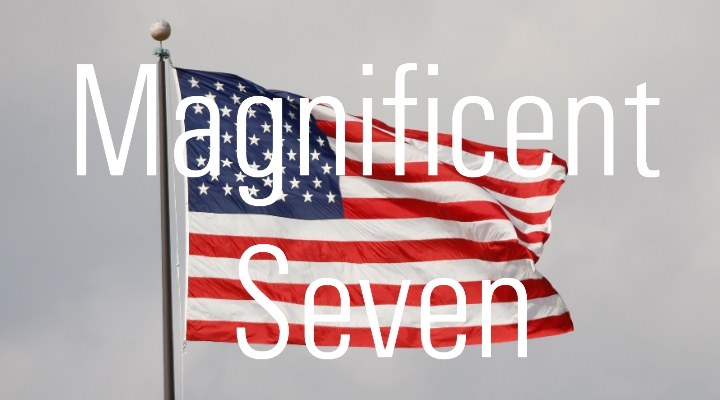
Most discussion of the "Magnificent Seven" stocks – Alphabet (GOOGL), Amazon.com (AMZN), Apple (AAPL), Meta Platforms (META), Microsoft (MSFT), Nvidia (NVDA), and Tesla (TSLA) – comes from either a) academic researchers who have learned to distrust growth stocks; b) portfolio managers who deplore other people's winners; or c) eternal optimists.
Their conclusions are thus forgone.
For many years, I occupied the first camp. The rise and fall of the go-go funds in the 1960s, the Nifty Fifty in the 1970s, and the technology darlings of the 1990s formed my view.
However, the performance of the "FANG" companies – Facebook (now Meta Platforms), Amazon, Netflix (NFLX), and Google (now Alphabet) – has changed my mind. Since 2013, those stocks have soared, even though they were already (in)famous by then.
I am therefore happy to take my inquiry into the Magnificent Seven wherever it may lead. If it determines the gains for the FANG stocks were anomalous, and that the usual dismal results for glamour stocks should be heeded when judging the Magnificent Seven, fine by me. If, on the other hand, it indicates that this time will once again be different, that will also be fine. Let the numbers rule.
I will use three yardsticks to compare the Magnificent Seven to their predecessors: 1) the extent to which the group dominates the US stock market, 2) the stocks' valuations, as scored price/earnings ratios, and 3) their prospective business growth. The first two items can readily be assessed. In contrast, the third consideration is critically important, but regrettably difficult to determine.
What is The Market Impact of The Magnificent Seven?
The chart below shows the percentage of Vanguard 500 Index (VFINX) invested in the portfolio's 10 largest stocks, from 1985 through January 2024.

We have entered uncharted territory!
Of that 29.9%, all but two percentage points come from the Magnificent Seven, which account for the entire top-10 stake except for a 1.7% position in Berkshire Hathaway (BRK.B) and 1.3% in Broadcom (AVGO). (The fund's top 10 positions include two helpings of Alphabet, courtesy of the company's A and C share classes. Although strangely, Vanguard combines Berkshire Hathaway's A and B share classes in its report. Go figure.)
An ill wind blows. For one, the only other time the index was anywhere near this concentrated was entering the year 2000, which was the very worst occasion on which to buy it. For another, 2013's unusually low percentage reminds us that when the FANG stocks first became famous, they had much room ahead of them. In spring 2013, Google, Amazon, and Netflix accounted for only 2.3% of the S&P 500, in aggregate. Facebook had not even been accepted into the index.
The top-10 indicator has a sample size of two, which is about as far from statistical significance as one can get. Its signal, however, is flashing bright red.
Magnificent Seven: What is The Value of Growth?
When using this measure, the Nifty Fifty can be included. I could not calculate the level of portfolio concentration for the S&P 500 during the 1970s, because I lacked that data. But I could get the price/earnings ratios for the Nifty Fifty stocks.
The next chart shows the median P/E ratios for 1) the Nifty Fifty at their 1972 highs, 2) the seven largest technology stocks in December 1999, and 3) the Magnificent Seven today.
(Note: The exhibit omits the ratios for the FANG stocks because, in March 2013, only Google boasted significant earnings. The ratios for the other FANG stocks were either nonexistent or incomprehensibly high, as those three firms were plowing all their free cash back into their businesses.)

That's much more encouraging.
By this measure, the Magnificent Seven are slightly cheaper than the Nifty Fifty were before those stocks imploded. While that achievement may seem dubious, given the latter's rather dire fate, there is a significant difference in circumstances. The Nifty Fifty was a much less exclusive group than the Magnificent Seven. Many of the Nifty Fifty's members ran ordinary businesses, not dominant ones.
What's more, the new millennium's stars were much costlier than today's aspirants. Among the biggest technology stocks of that era, only the decades-old organisations of Intel (INTC) and IBM (IBM) carried P/E ratios that resembled those of the Magnificent Seven.
The Key Thing is Business Prospects
Ultimately, operational results matter most when determining future long-term stock market returns. The Nifty Fifty failed that test because they embodied the overall US economy – the club possessed too many members and included too many industries to be otherwise – and the nation's economy fared poorly over the next decade. In fact, when adjusted for inflation, earnings for the S&P 500's companies were lower in 1982 than they were 10 years before.
By contrast, 1999's technology stock contenders stood a chance. They were a small group, occupying only the expanding technology and telecommunications sectors. Unfortunately, they contained too many duds and not enough long-term winners.
AOL and Lucent went kersplat. Not much better were Cisco (CSCO) and IBM, which posted lower net incomes in 2023 than they had 24 years earlier, in 1999. Among those companies, only Microsoft has meaningfully outgained the Morningstar US Market Index since the new millennium began. One was not nearly enough.

Then came the best performance by glamour stocks. Unlike their predecessors, the FANG stocks have enjoyed great operating success. In barely more than a decade, they have grown their collective revenue ninefold and their earnings elevenfold. With those outstanding fundamental results, their initial prices became beside the point. They were bound to post terrific stock market returns.
Conclusion
Neither the Nifty Fifty nor the FANG stocks can serve as useful comparisons for the Magnificent Seven. The Nifty Fifty represented the destiny of the overall US industry, whereas the Magnificent Seven are, although extremely large, a specific branch of the economy. And the FANG stocks were in a different position entirely. In 2013, their businesses were much smaller and newer than are today’s Magnificent Seven. Their growth potential was therefore materially higher.
The experience of the new millennium's leaders, though, provides a useful starting point for assessing the Magnificent Seven’s destiny. At the time, those new millennium businesses were similarly prized by investors, and they occupied what were then regarded as similarly exciting, cutting-edge industries.
As we have seen, their subsequent returns were poor. However, the shortfall largely occurred for one reason that does not strike me as applicable to the Magnificent Seven, and for another that is certainly not. First, two of 1999's companies soon caved. Perhaps my imagination fails me, but it’s hard for me to envision any of the Magnificent Seven suffering the same immediate fate. Second, the new millennium firms were far more expensive than their successors.
After considering all factors, I expect the 10-year returns for the Magnificent Seven to fall roughly in line with that of other US equities. On the bright side, they will grow their businesses faster than most, although nowhere nearly as aggressively as the FANG stocks managed. But their price multiples, while not absurd, will likely decline over the years, as their operations continue to mature.
In short, I would not buy the Magnificent Seven stocks myself because I wish to perverse my peace of mind (I distrust expensive securities), but I do not decry those who do.
Over time, I expect that investment to post a competitive gain.
The author or authors do not own shares in any securities mentioned in this article. This article was originally published on Morningstar.com for a U.S. audience.





:quality(80)/cloudfront-us-east-1.images.arcpublishing.com/morningstar/COEN5HSNPJADTNHKGM2DEXMLNI.jpg)

:quality(80)/cloudfront-us-east-1.images.arcpublishing.com/morningstar/P7AZQBQECRCAXCMWYRBKCH47HQ.png)















